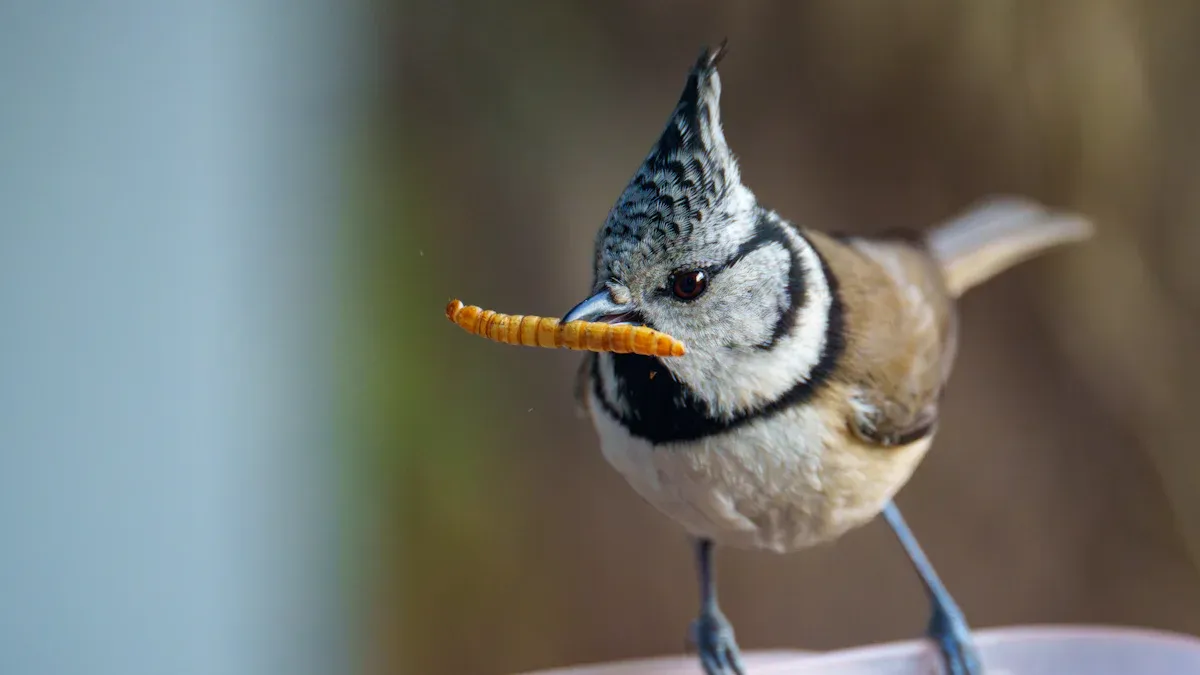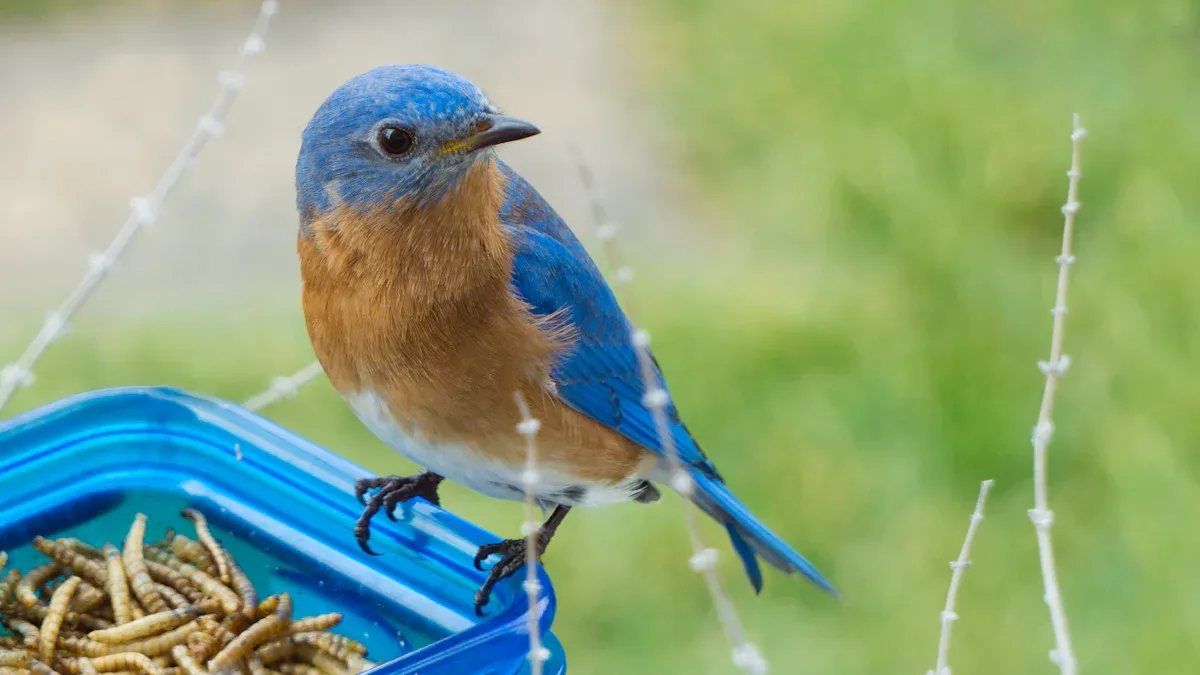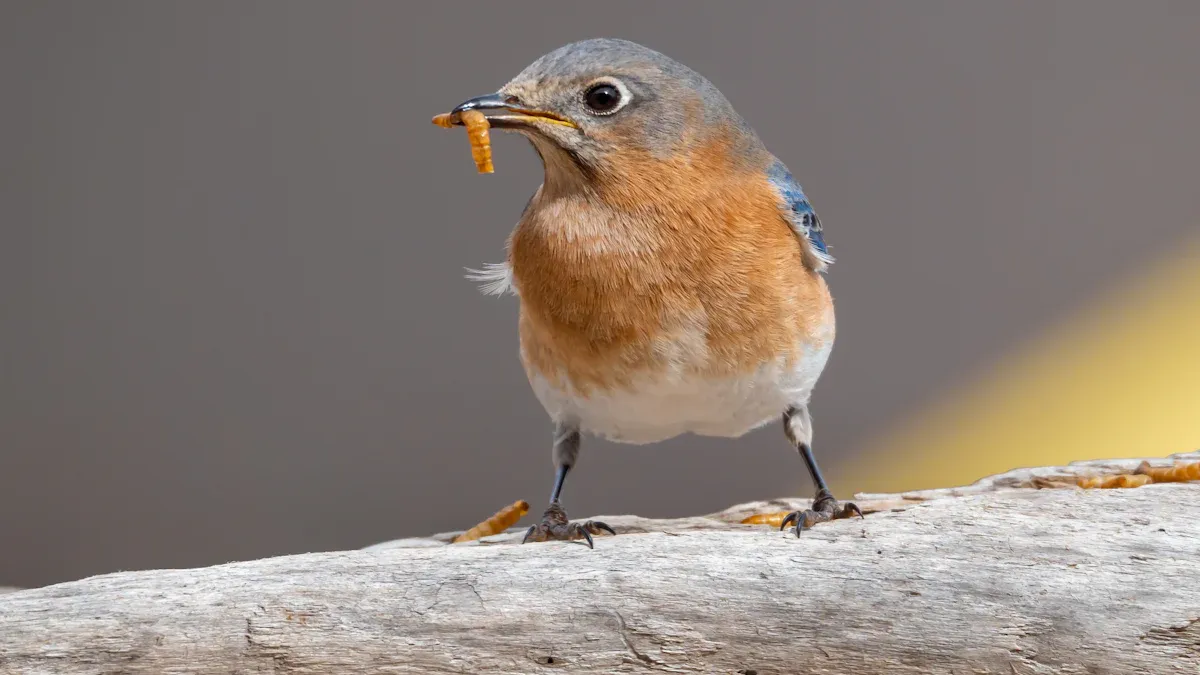
Imagine turning your backyard into a bird paradise. Mixing dried mealworms with bird food seed does just that! Packed with protein, fat, and essential nutrients, mealworms keep birds healthy and happy.
Dried mealworms can be mixed with other seeds, fruits, or suet pellets to create a balanced diet for birds.
Here’s the breakdown of their nutritional power:
- Crude Protein: 52.8%
- Crude Fat: 24.7%
- Calcium: 0.05%
- Phosphorus: 1.03%
This mix not only nourishes birds but also attracts a variety of species to your feeder. Get ready for a front-row seat to nature’s show!
Key Takeaways
- Mix dried mealworms with bird food seed to create a nutritious meal that attracts a variety of bird species.
- Use a ratio of 3 parts seed to 1 part mealworms for a balanced diet that supports birds’ health and energy needs.
- Place the mix in platform or hopper feeders for easy access, and refill daily to keep the food fresh and appealing.
Benefits of Combining Dried Mealworms with Bird Food Seed

Nutritional Advantages for Birds
Think of dried mealworms as a superfood for your feathered friends. These tiny treats are packed with protein, essential fatty acids, and fiber. They help birds build strong muscles, maintain energy, and stay active throughout the day. Pairing them with bird food seed creates a balanced diet that supports overall health. Seeds provide carbohydrates and fats, while mealworms add the protein punch birds need. Together, they form a powerhouse combo that keeps birds thriving.
Fun fact: Mealworms are 100% natural and non-GMO, making them a guilt-free snack for your backyard visitors!
Attracting a Variety of Bird Species
Want to turn your yard into a birdwatcher’s dream? This mix can do the trick! Mealworms appeal to over 30 bird species, including chickadees, nuthatches, jays, and woodpeckers. Birds can’t resist the protein-rich goodness of mealworms combined with the familiar crunch of seeds. You’ll see a colorful parade of birds flocking to your feeder, each bringing its unique charm.
- Why birds love this mix:
- It mimics their natural diet.
- It’s easy to eat and digest.
- It provides the energy they need to soar.
Seasonal Benefits for Breeding and Migration
During breeding and migration seasons, birds need extra energy and nutrients. Mealworms provide the protein necessary for egg production and chick development. They also help migratory birds fuel up for their long journeys. Mixing mealworms with bird food seed ensures birds get the balanced nutrition they need during these critical times. By offering this mix, you’re not just feeding birds—you’re supporting their survival and success.
Types of Birds That Eat Dried Mealworms and Bird Food Seed

Common Backyard Birds
Your backyard is home to some of the most delightful bird species. Bluebirds, robins, and sparrows are just a few of the regulars that will eagerly snack on dried mealworms mixed with bird food seed. These birds love the combination because it mimics their natural diet. You’ll often spot them hopping around your feeder, chirping happily as they enjoy their meal.
Tip: Place the mix in a shallow dish or platform feeder to make it easy for these ground-feeding birds to access.
Watching these feathered friends up close is like having a nature documentary unfold right in your yard. Their vibrant colors and cheerful songs will brighten your day!
Seasonal Visitors and Migratory Birds
When the seasons change, so do your visitors. Migratory birds like warblers, orioles, and thrushes pass through during spring and fall. These travelers need extra energy for their long journeys, and your mix of mealworms and bird food seed provides the perfect fuel.
Imagine the thrill of spotting a bright orange oriole or a lively warbler at your feeder. These seasonal guests bring a splash of color and excitement to your yard. By offering this mix, you’re giving them a much-needed pit stop on their journey.
Birds That Require High-Protein Diets
Some birds need more protein than others. Woodpeckers, wrens, and chickadees fall into this category. They rely on protein to maintain their strength and energy, especially during nesting and breeding seasons.
Dried mealworms are a game-changer for these birds. Pairing them with bird food seed ensures they get the balanced nutrition they crave. You’ll notice these birds returning to your feeder again and again, drawn by the irresistible combination.
Fun fact: Chickadees can remember hundreds of feeding spots, so once they find your feeder, they’ll keep coming back!
Practical Tips for Feeding Dried Mealworms with Bird Food Seed
How to Mix Mealworms with Bird Food Seed
Creating the perfect mix is easier than you think! Start by grabbing your favorite bird food seed and a handful of dried mealworms. Use a ratio of about 3 parts seed to 1 part mealworms. This balance ensures birds get a variety of nutrients. Toss the ingredients together in a bowl or container. Shake it up like you’re making a gourmet recipe for your feathered friends!
Pro Tip: If you notice birds picking out the mealworms first, try adding a few extra to the mix. They’ll love the treat, and you’ll enjoy watching them feast!
Best Feeder Types for This Combination
Not all feeders are created equal. For this mix, platform feeders or hopper feeders work best. These designs allow birds to easily access both the seeds and mealworms. If you’re catering to ground-feeding birds like robins or sparrows, a shallow dish placed on the ground works wonders.
Avoid tube feeders for this combo. Mealworms can get stuck, making it harder for birds to enjoy their meal. Keep it simple and accessible, and you’ll see a variety of birds flocking to your yard.
Tips for Soaking and Presenting Mealworms
Dried mealworms are great as-is, but soaking them can make them even more appealing. Place the mealworms in a bowl of warm water for about 10-15 minutes. This rehydrates them, making them softer and easier for birds to eat. Once soaked, drain the water and mix them with your bird food seed.
Note: Soaked mealworms spoil faster, so only prepare what you’ll use in a day.
For presentation, sprinkle the mix in your feeder or dish. Keep it fresh by refilling daily, and watch as birds return for more of your delicious creation!
Troubleshooting Common Feeding Issues
Encouraging Birds to Eat the Mix
Sometimes birds can be a bit picky. If they’re ignoring your mix, don’t worry—you can win them over! Start by offering dried mealworms separately in a shallow dish. Birds love these protein-packed snacks, and once they get a taste, they’ll come back for more. Gradually mix the mealworms with bird food seed to introduce the combination.
Tip: Place the feeder in a quiet, shaded spot. Birds feel safer when they’re away from predators and noise.
If you’re still not seeing visitors, try sprinkling a small amount of the mix on the ground. Ground-feeding birds like robins and sparrows will appreciate the easy access. Patience is key—once birds discover your feeder, they’ll spread the word!
Proper Storage of Mealworms and Seed
Keeping your bird food fresh is essential. Store dried mealworms and seeds in airtight containers to prevent moisture and pests. A cool, dry place like a pantry or garage works best.
Pro Tip: Label your containers with the purchase date. This helps you keep track of freshness and ensures you’re always offering high-quality food.
Avoid leaving the mix in the feeder for too long, especially in humid weather. Replace it daily to keep it fresh and appealing to birds.
Preventing Pests and Maintaining Cleanliness
Uninvited guests like squirrels and ants can crash your bird buffet. To keep them away, use feeders with built-in pest guards or baffles. Clean your feeders regularly with warm, soapy water to remove debris and bacteria.
Note: A clean feeding area not only deters pests but also keeps your feathered friends healthy and happy.
By following these tips, you’ll create a safe and inviting space for birds to enjoy their mealworm-seed mix. 🐦
Mixing dried mealworms with bird food seed is your ticket to creating a bird haven in your yard. This simple combo fuels birds with essential nutrients while attracting a colorful variety of species.
Pro Tip: A well-fed bird is a happy bird—and a joy to watch!
Try this method today and enjoy the magic of bird feeding. 🐦
FAQ
How often should you refill the feeder with the mealworm-seed mix?
Birds love fresh food! Refill daily to keep the mix appealing. This also prevents spoilage and ensures your feathered friends always have a tasty treat waiting. 🐦
Can you feed dried mealworms to baby birds?
Yes, but soak them first! Rehydrated mealworms are softer and easier for baby birds to eat. This helps them get the protein they need to grow strong.
What if squirrels keep stealing the mix?
Use a squirrel-proof feeder! These feeders have clever designs that keep squirrels out while letting birds feast in peace. Problem solved, and your birds stay happy! 🐿️


